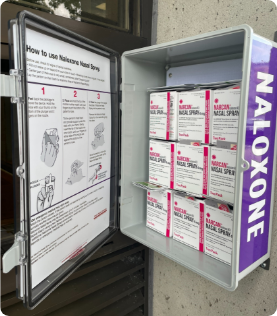Innovative Strategy: Naloxone Cabinets
- Naloxone is a medication that rapidly reverses an opioid overdose if given in time.
- Naloxone availability remains a barrier to rapid overdose response.
- Community naloxone cabinets are non-locked mounted containers that provide immediate access to naloxone.
- Naloxone cabinets are de-stigmatized, anonymous sources of naloxone installed in overdose hotspots, or areas within communities reporting a higher incidence of overdose.
Potential Benefits to Community
- Supplies naloxone to people in high-risk areas and with limited access.
- More convenient and private than accessing through a syringe service program.
- Accessible at no cost and 24 hours a day.
- Allows opportunity for bystander rescue before first responder arrival.
- Normalizes naloxone as a publicly accessible safety and rescue resource, much like an AED.
- Fosters sustainable partnerships with community organizations through planning and implementation in overdose hotspots.
- A first step to engaging individuals at high risk who may be resistant to outreach.

 Estimated Time from Planning to Implementation
Estimated Time from Planning to Implementation
Approximately 3 months*
Collaborating with Community Partners
Implementers should partner with community organizations, such as local businesses, coalitions, or advocacy groups, to collect community input prior to the installation of a naloxone cabinet. Community partners can help assess community acceptance and understanding of naloxone cabinet, as well as educate the public and support implementation.
Cost Considerations
- Price of a cabinet: $200- 400*, depending on supplier.
- Price for naloxone units to stock cabinet: Varies by supplier; More information on cost considerations for OEND implementation may be found on page 30 of the ORCCA Practice Guide .
- Additional funding for staffing or volunteers to monitor and restock cabinets.
Operational Considerations
- Identify installation locations that are visible, accessible, and central to overdose hotspots.
- Gas stations, public libraries, town halls, public housing, courthouses, public transit stations
- Navigate permissions with the municipality.
- Establish naloxone monitoring and restocking protocols and agreements with community partners.
- Consider regular in-person inventory monitoring by approachable, non-judgmental outreach staff.
- Secure (or purchase) a naloxone cabinet and naloxone units to stock.
- Will the cabinet be locked or require a key to open? Will unlock ignite a siren or automatic call to emergency medical services?
- Will the cabinet include rescue breathing instructions?
- Track community use (counted units accessed) to report to implementation stakeholders and community partners.
- Consider whether and how to promote the presence of cabinet based on social norms.
Evaluation metrics
- Consider tracking the following information to help measure success of the program.
- Number of kits re-stocked on a weekly or monthly basis (subtracted from full stock)
- Survey of community member acceptability or request community feedback
Acknowledgements
We wish to express our thanks to all community partners who have implemented these programs during the HEALing Communities Study. Key insights from these partners were crucial in the development of these resources that will be important tools for programs looking to build on the successes of these strategies to reduce fatal overdoses.
*Based on data collection from implementation partners during the HCS